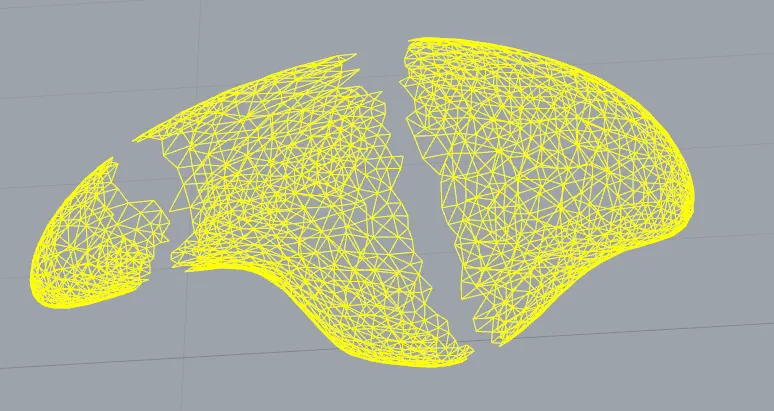2个回答
3
当我开始使用CGAL时,我几乎立即遇到了这个问题。仔细阅读多边形网格文档后,我找到了解决方案。基本上,通过修改版的Corefinement,您可以平滑地将两个不同的几何体网格拼合在一起,无论它们的多边形数量或形状如何(但是,多边形之间的差异越大,就越不有效)。
您需要做的第一件事是确保几何体不自相交。其次,确保
您需要做的第一件事是确保几何体不自相交。其次,确保
CGAL :: Polygon_mesh_processing :: clip()在这两个几何体上处于活动状态(我建议使用close_volumes = false)。然后,计算这两个新网格的并集:#include <CGAL/Exact_predicates_inexact_constructions_kernel.h>
#include <CGAL/Surface_mesh.h>
#include <CGAL/Polygon_mesh_processing/corefinement.h>
#include <fstream>
typedef CGAL::Exact_predicates_inexact_constructions_kernel K;
typedef CGAL::Surface_mesh<K::Point_3> Mesh;
namespace PMP = CGAL::Polygon_mesh_processing;
int main(int argc, char* argv[])
{
const char* filename1 = (argc > 1) ? argv[1] : "data/blobby.off";
const char* filename2 = (argc > 2) ? argv[2] : "data/eight.off";
std::ifstream input(filename1);
Mesh mesh1, mesh2;
if (!input || !(input >> mesh1))
{
std::cerr << "First mesh is not a valid off file." << std::endl;
return 1;
}
input.close();
input.open(filename2);
if (!input || !(input >> mesh2))
{
std::cerr << "Second mesh is not a valid off file." << std::endl;
return 1;
}
Mesh out;
bool valid_union = PMP::corefine_and_compute_union(mesh1,mesh2, out);
if (valid_union)
{
std::cout << "Union was successfully computed\n";
std::ofstream output("union.off");
output << out;
return 0;
}
std::cout << "Union could not be computed\n";
return 1;
}
与使用来自具有精确构造的内核的点的网格不同,精确点是网格顶点的属性,我们可以在稍后的操作中重用。通过这个属性,我们可以操作具有浮点坐标的点的网格,但又能从精确构造提供的鲁棒性中受益。
#include <CGAL/Exact_predicates_inexact_constructions_kernel.h>
#include <CGAL/Exact_predicates_exact_constructions_kernel.h>
#include <CGAL/Surface_mesh.h>
#include <CGAL/Polygon_mesh_processing/corefinement.h>
#include <fstream>
typedef CGAL::Exact_predicates_inexact_constructions_kernel K;
typedef CGAL::Exact_predicates_exact_constructions_kernel EK;
typedef CGAL::Surface_mesh<K::Point_3> Mesh;
typedef boost::graph_traits<Mesh>::vertex_descriptor vertex_descriptor;
typedef Mesh::Property_map<vertex_descriptor,EK::Point_3> Exact_point_map;
typedef Mesh::Property_map<vertex_descriptor,bool> Exact_point_computed;
namespace PMP = CGAL::Polygon_mesh_processing;
namespace params = PMP::parameters;
struct Coref_point_map
{
// typedef for the property map
typedef boost::property_traits<Exact_point_map>::value_type value_type;
typedef boost::property_traits<Exact_point_map>::reference reference;
typedef boost::property_traits<Exact_point_map>::category category;
typedef boost::property_traits<Exact_point_map>::key_type key_type;
// exterior references
Exact_point_computed* exact_point_computed_ptr;
Exact_point_map* exact_point_ptr;
Mesh* mesh_ptr;
Exact_point_computed& exact_point_computed() const
{
CGAL_assertion(exact_point_computed_ptr!=NULL);
return *exact_point_computed_ptr;
}
Exact_point_map& exact_point() const
{
CGAL_assertion(exact_point_ptr!=NULL);
return *exact_point_ptr;
}
Mesh& mesh() const
{
CGAL_assertion(mesh_ptr!=NULL);
return *mesh_ptr;
}
// Converters
CGAL::Cartesian_converter<K, EK> to_exact;
CGAL::Cartesian_converter<EK, K> to_input;
Coref_point_map()
: exact_point_computed_ptr(NULL)
, exact_point_ptr(NULL)
, mesh_ptr(NULL)
{}
Coref_point_map(Exact_point_map& ep,
Exact_point_computed& epc,
Mesh& m)
: exact_point_computed_ptr(&epc)
, exact_point_ptr(&ep)
, mesh_ptr(&m)
{}
friend
reference get(const Coref_point_map& map, key_type k)
{
// create exact point if it does not exist
if (!map.exact_point_computed()[k]){
map.exact_point()[k]=map.to_exact(map.mesh().point(k));
map.exact_point_computed()[k]=true;
}
return map.exact_point()[k];
}
friend
void put(const Coref_point_map& map, key_type k, const EK::Point_3& p)
{
map.exact_point_computed()[k]=true;
map.exact_point()[k]=p;
// create the input point from the exact one
map.mesh().point(k)=map.to_input(p);
}
};
int main(int argc, char* argv[])
{
const char* filename1 = (argc > 1) ? argv[1] : "data/blobby.off";
const char* filename2 = (argc > 2) ? argv[2] : "data/eight.off";
std::ifstream input(filename1);
Mesh mesh1, mesh2;
if (!input || !(input >> mesh1))
{
std::cerr << "First mesh is not a valid off file." << std::endl;
return 1;
}
input.close();
input.open(filename2);
if (!input || !(input >> mesh2))
{
std::cerr << "Second mesh is not a valid off file." << std::endl;
return 1;
}
Exact_point_map mesh1_exact_points =
mesh1.add_property_map<vertex_descriptor,EK::Point_3>("e:exact_point").first;
Exact_point_computed mesh1_exact_points_computed =
mesh1.add_property_map<vertex_descriptor,bool>("e:exact_points_computed").first;
Exact_point_map mesh2_exact_points =
mesh2.add_property_map<vertex_descriptor,EK::Point_3>("e:exact_point").first;
Exact_point_computed mesh2_exact_points_computed =
mesh2.add_property_map<vertex_descriptor,bool>("e:exact_points_computed").first;
Coref_point_map mesh1_pm(mesh1_exact_points, mesh1_exact_points_computed, mesh1);
Coref_point_map mesh2_pm(mesh2_exact_points, mesh2_exact_points_computed, mesh2);
if ( PMP::corefine_and_compute_intersection(mesh1,
mesh2,
mesh1,
params::vertex_point_map(mesh1_pm),
params::vertex_point_map(mesh2_pm),
params::vertex_point_map(mesh1_pm) ) )
{
if ( PMP::corefine_and_compute_union(mesh1,
mesh2,
mesh2,
params::vertex_point_map(mesh1_pm),
params::vertex_point_map(mesh2_pm),
params::vertex_point_map(mesh2_pm) ) )
{
std::cout << "Intersection and union were successfully computed\n";
std::ofstream output("inter_union.off");
output << mesh2;
return 0;
}
std::cout << "Union could not be computed\n";
return 1;
}
std::cout << "Intersection could not be computed\n";
return 1;
}
- Vendetta
4
0
网格最初是什么样子的?合并不同的组件而不是移除最小的部分是否可行?请参见CGAL combinatorical repairing以获取更多信息。
连接不同的组件是一个相当困难的问题。我认为常规的孔填充算法只适用于有界孔,即存在一条开放边缘绕着孔并最终回到起点。
我的建议是分析网格以找到需要连接的开放边缘列表,即红色、绿色、蓝色和紫色线条。找到一种将它们彼此配对的方法,例如reg-green和blue-purple。在这个例子中,只需使用边缘的平均值进行配对就足够了。
然后,您需要一些方法来三角化边缘之间的间隙。正如您提到的那样,创建一个(或两个)三角形来连接部分应该足够了,并使用类似CGAL::Polygon_mesh_processing::triangulate_refine_and_fair_hole的方法来填充其余部分。
连接不同的组件是一个相当困难的问题。我认为常规的孔填充算法只适用于有界孔,即存在一条开放边缘绕着孔并最终回到起点。
我的建议是分析网格以找到需要连接的开放边缘列表,即红色、绿色、蓝色和紫色线条。找到一种将它们彼此配对的方法,例如reg-green和blue-purple。在这个例子中,只需使用边缘的平均值进行配对就足够了。
然后,您需要一些方法来三角化边缘之间的间隙。正如您提到的那样,创建一个(或两个)三角形来连接部分应该足够了,并使用类似CGAL::Polygon_mesh_processing::triangulate_refine_and_fair_hole的方法来填充其余部分。
为了实现这个目标,您可以尝试找到每个列表中彼此靠近的两个边缘。即点距离之和尽可能小。因此,从一个列表中选择一个边缘,并找到另一个列表中最接近的边缘。当您有两个边缘时,添加一对三角形并使用CGAL填充其余部分。不同的部分应具有相同的表面方向才能正常工作,但这可能是情况。
另一种方法是仅使用顶点从点云创建网格,但不能保证与当前网格匹配。最简单的解决方案可能是尽量避免问题,即确保网格源产生定义良好的连接网格。
- JonasH
1
谢谢您的回复,这确实是我一直在努力的方法,我几乎完成了编程,目前遇到的问题是面朝错误的方向,因此填充孔失败。 - Niels
网页内容由stack overflow 提供, 点击上面的可以查看英文原文,
原文链接
原文链接


corefine_and_compute_union和corefine_and_compute_intersection。文档中也没有给出清晰的解释。您能否稍微解释一下? - Nielscorefine_and_compute_union计算网格中重叠的部分,并需要将其移除并替换为多边形填充。corefine_and_compute_intersection与前者类似,但使用现有网格来填充切口,而不是生成平滑的网格填充。第一个函数通常需要精确的输入才能工作,但第二个函数允许将其作为参数传递。 - Vendetta